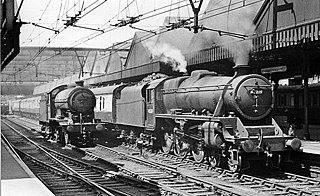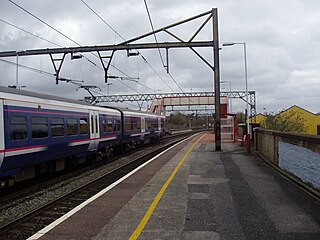
Sheffield Victoria was the main railway station in Sheffield, South Yorkshire, England, on the Great Central Railway,

Penistone railway station serves the town of Penistone, in the Metropolitan Borough of Barnsley, South Yorkshire, England. Services are provided by Northern Trains. The current station, at the junction of the Woodhead Line and Penistone Line, opened in 1874; it replaced a station solely on the Woodhead Line, dating from the line's opening by the Sheffield, Ashton-Under-Lyne and Manchester Railway in 1845.

Woodhouse railway station serves Woodhouse and Woodhouse Mill in Sheffield, South Yorkshire, England. The station is 5.25 miles (8 km) east of Sheffield station on the Sheffield to Lincoln Line.

Nottingham Victoria railway station was a Great Central Railway and Great Northern Railway railway station in Nottingham, England. It was designed by the architect Albert Edward Lambert, who also designed the rebuild of the Nottingham Midland station.

Ashburys railway station is in Openshaw, Manchester, England, on the Manchester-Glossop Line at its junction with the Hope Valley line and the freight line to Phillips Park Junction. It has been open since 1855 and is the nearest railway station to the City of Manchester Stadium.

Guide Bridge railway station serves Guide Bridge in Audenshaw, Greater Manchester, England, and is operated by Northern Trains. The station is 4+3⁄4 miles (7.6 km) east of Manchester Piccadilly on both the Rose Hill Marple and Glossop Lines.
The Manchester–Sheffield–Wath electric railway was an electrification scheme on British railways. The route featured long ascents on both sides of the Pennines with the long Woodhead Tunnel at its central summit close to the Woodhead pass. This led to the route being called the Woodhead Line.

Wadsley Bridge railway station was a station in Sheffield, South Yorkshire, England on the Great Central Railway's core route between Manchester and Sheffield.

Ramsbottom railway station is a heritage station serving the town of Ramsbottom in Greater Manchester, England.

Dunford Bridge railway station was a railway station that served the village of Dunford Bridge on the Sheffield, Ashton-under-Lyne and Manchester Railway situated immediately east of the Woodhead Tunnel, 5 miles (8 km) west of Penistone, within the Metropolitan Borough of Barnsley, South Yorkshire, England.

Hazlehead Bridge railway station was a railway station on the Sheffield, Ashton-under-Lyne and Manchester Railway's Woodhead Line. It served villages scattered over a wide area of South Yorkshire, England, and was adjacent to the bridge over the Huddersfield Road.
Clayton Bridge railway station, Manchester, was a railway station that served the locality between 1846 and 1968.

Stockport Tiviot Dale was one of two main railway stations serving the town of Stockport, Cheshire, England; the other being Stockport Edgeley.

Park Bridge Railway Station was a railway station on the Oldham, Ashton-under-Lyne and Guide Bridge Junction Railway (OA&GB) that served the village of Park Bridge, in the Medlock Valley near Ashton-under-Lyne's border with Oldham. It was sometimes known as Parkbridge, and one photograph of the station shows the station name board with the name as one word and immediately adjacent the signal box with it shown as two. The station opened on 26 August 1861 when the line opened.
For other stations named Ashton, see Ashton railway station (disambiguation)

Queensbury railway station was a station on the Queensbury lines serving the village of Queensbury, West Yorkshire, England. The station was unusual due to its triangular shape, and at its opening the only other examples of this arrangement were Ambergate station in Derbyshire and Earlestown in Lancashire; since then Shipley station, also in West Yorkshire, has gained platforms on all three sides. Of the stations on the Queensbury lines, this was the most ambitious.

Neepsend is a suburb of the city of Sheffield, it stands just 1 mile (1.6 km) north-west of the city centre. The main area of Neepsend covers the flood plain of the River Don from Lady's Bridge at the Wicker up to Hillfoot Bridge. The suburb falls within the Central Ward of the city. The adjacent district of Parkwood Springs is often regarded as part of the suburb.

Killamarsh Central is a former railway station in Killamarsh, Derbyshire, England.

Godley East was a railway station in the Godley area of Hyde, Tameside, Greater Manchester, on the Woodhead Line.

Kildwick and Crosshills [sic] was a railway station off Station Road in Cross Hills, North Yorkshire, England. It served the villages of Cross Hills, Cowling, Glusburn, Kildwick and Sutton-in-Craven.


















